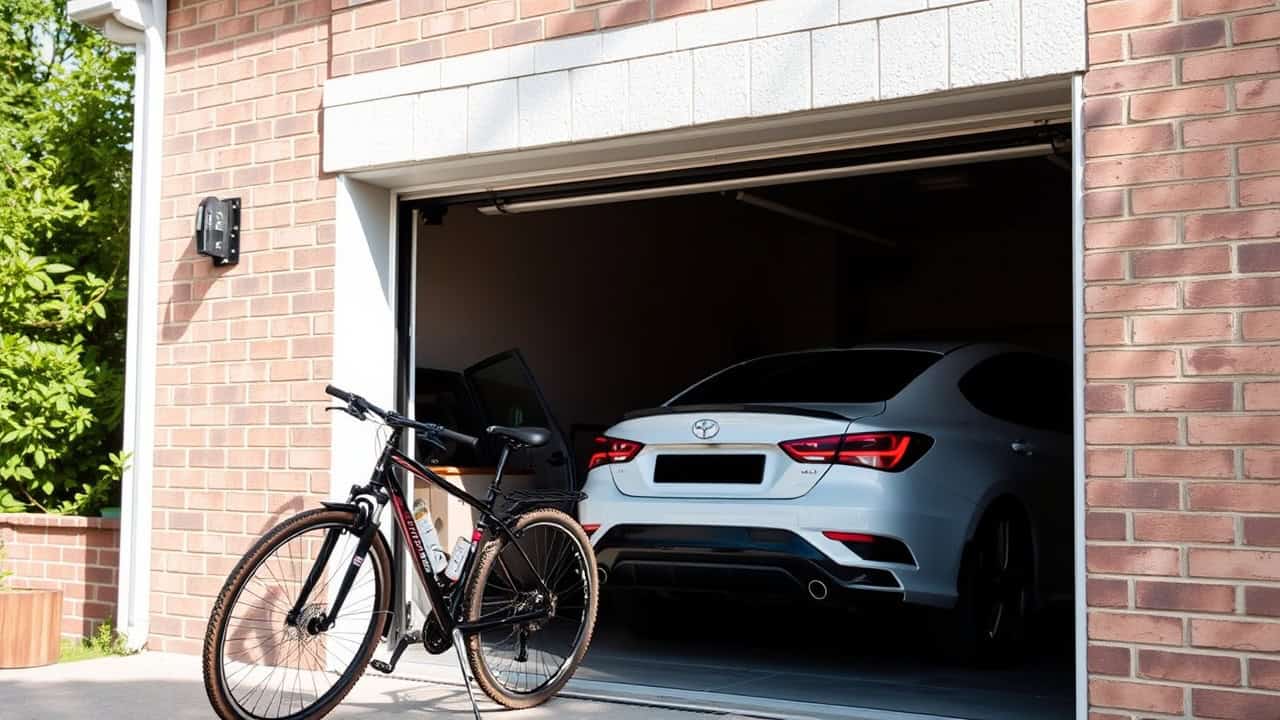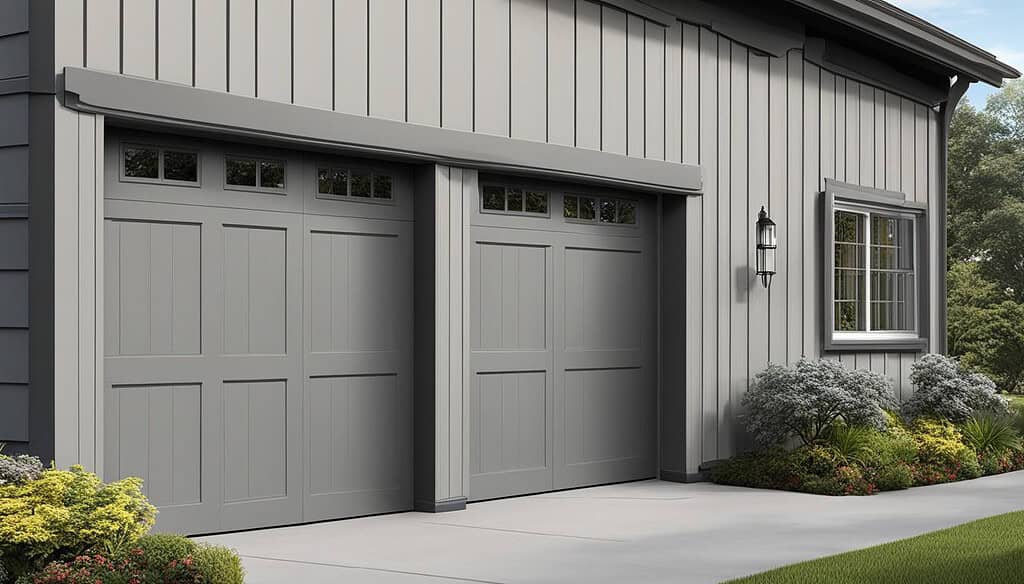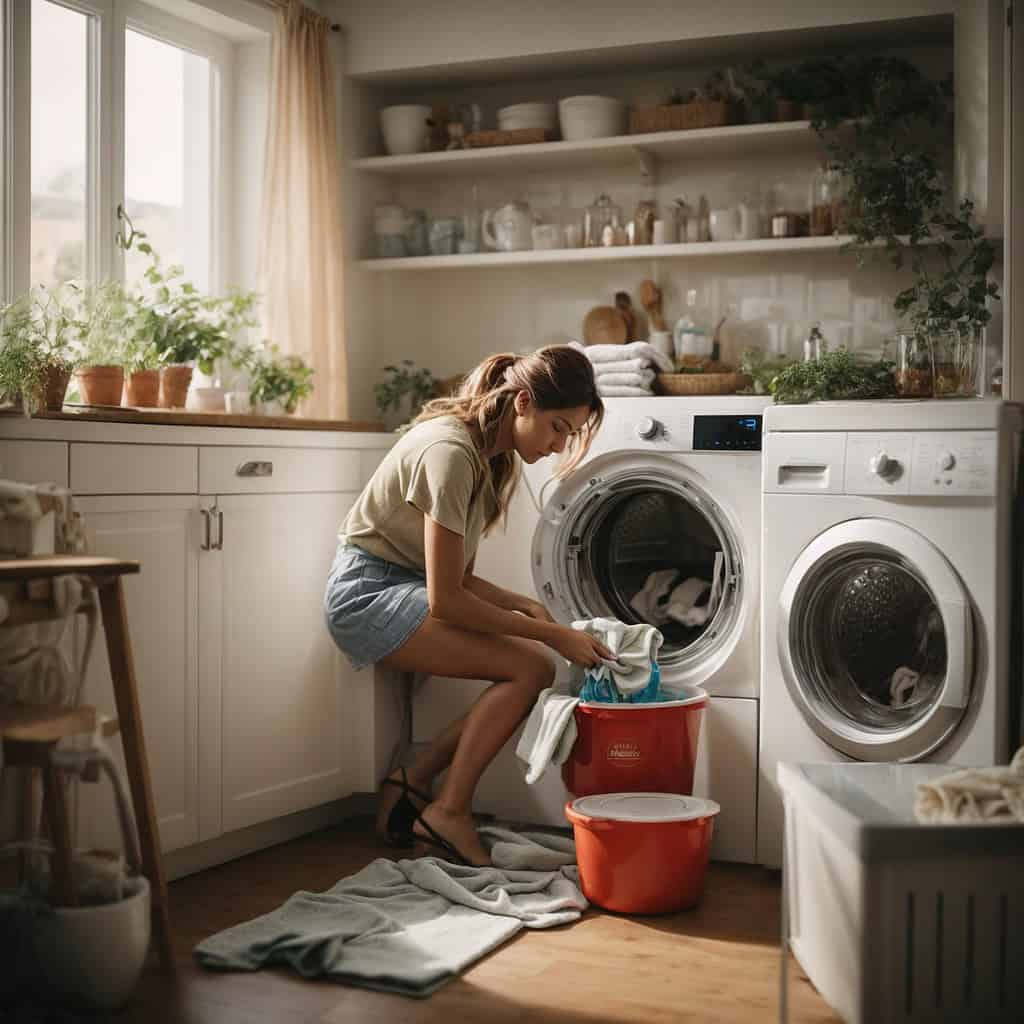
Have you ever winced at the rattling and clanging of your garage door, wondering if the whole neighborhood notices every time it opens or closes?
You’re not alone.
A noisy garage door isn’t just an annoying start or end to your day—it can be a sign that your door needs a bit of care.
I remember when my own garage door sounded like a rusty old drawbridge, announcing my comings and goings louder than I’d prefer. It was then I realized that with some simple maintenance, I could bring back the smooth, quiet operation it once had.
The good news is, that quieting a noisy garage door is often easier than you might think. With a few tools and a little time, you can tackle the common culprits behind the noise.
In this guide, we’ll explore the typical causes of garage door noises and walk through practical steps to silence them. Let’s get started on bringing peace and quiet back to your garage.
Identifying the Source of the Noise
Ever wondered why your garage door sounds like a marching band? Let’s find out what’s causing all that racket.
Understanding the source of the noise helps in choosing the right fix.
A noisy garage door opener can be annoying, but don’t worry. We’ll tackle this together.
Common Noise Culprits
Loose Hardware
Loose hardware often causes a lot of noise. Bolts, nuts, and screws can loosen over time. This happens due to the constant movement of the garage door.
When hardware becomes loose, it creates rattling sounds.
You can easily fix this by tightening everything up. Use a wrench to secure all bolts and screws.
Worn Rollers
Worn rollers are another common issue. Rollers help the garage door move smoothly along the tracks. Over time, they wear out or become damaged.
Worn rollers make grinding or squeaking noises. Replacing old rollers with new ones can solve this problem. Nylon rollers are quieter than steel ones, so consider using them.
Conducting a Noise Test
Listening for Specific Sounds
Listening carefully can help identify the noise source. Open and close the garage door a few times. Pay attention to where the noise comes from. Does it sound like grinding, squeaking, or rattling? Each sound points to a different issue. For example, grinding might mean worn rollers. Squeaking could indicate a need for lubrication. Rattling often means loose hardware.
Visual Inspection Tips
A visual inspection can reveal a lot. Look at the garage door opener and its components. Check for any visible damage or wear. Examine the rollers, hinges, and springs. Make sure everything looks intact and in place. If something seems off, it might be the noise culprit.
Here’s a quick table to summarize common noise sources and their solutions:
|
Noise Source |
Sound Type |
Solution |
|---|---|---|
|
Loose Hardware |
Rattling |
Tighten bolts and screws |
|
Worn Rollers |
Grinding |
Replace with nylon rollers |
|
Lack of Lubrication |
Squeaking |
Apply garage door lubricant |
Key Takeaways:
-
Identifying the noise source is the first step in fixing a noisy garage door.
-
Loose hardware and worn rollers are common culprits.
-
Conduct a noise test by listening and visually inspecting the garage door.
-
Use the right tools and materials for effective repairs.
Basic Maintenance and Quick Fixes
Ever had a garage door that sounds like a drum set? A noisy garage door can be quite the annoyance. The good news is that basic maintenance and quick fixes can often solve the problem. Let’s dive into some simple steps to fix garage door noise.
Tightening Loose Parts
Loose parts can create a symphony of unwanted sounds. Tightening these parts can make a world of difference.
Tools Needed
You’ll need a few tools to get started:
-
Socket Wrench Set: Essential for tightening bolts and nuts.
-
Adjustable Wrench: Handy for various sizes of hardware.
-
Screwdriver: Useful for screws that might need attention.
Step-by-Step Process
-
Identify Loose Parts: Check the door’s hinges, brackets, and tracks. Look for any wobbly or loose components.
-
Tighten Bolts and Nuts: Use the socket wrench to secure any loose bolts and nuts. Ensure everything is snug but not overly tight.
-
Check Screws: Use the screwdriver to tighten any loose screws. Pay special attention to the hinges and brackets.
-
Inspect Tracks: Make sure the tracks are aligned and secure. Adjust if necessary using the adjustable wrench.
Lubricating Moving Parts
Lubrication plays an important part in reducing noise. Proper lubrication ensures smooth operation.
Recommended Lubricants
Choosing the right lubricant is key. Here are some top picks:
-
Silicone Lubricant: Ideal for garage doors. Avoid heavy oils that can cause sticky buildup.
-
White Lithium Grease: Excellent for reducing noise and preventing dust accumulation.
-
Garage-Door-Specific Lubricant: Designed for hinges, rollers, and tracks.
Application Techniques
-
Clean the Area: Wipe down the moving parts to remove dirt and debris.
-
Apply Lubricant: Use the silicone lubricant on the rollers, hinges, and tracks. Apply white lithium grease to the springs.
-
Avoid Over-Lubrication: Use just enough to coat the parts. Wipe off any excess to prevent drips.
-
Test the Door: Open and close the door a few times to ensure smooth movement.
Below is a table on recommended lubricants:
|
Lubricant Type |
Best For |
Avoid Using On |
|---|---|---|
|
Silicone Lubricant |
Rollers, Hinges, Tracks |
Nylon Rollers |
|
White Lithium Grease |
Springs, Metal Parts |
Areas Prone to Dust |
|
Garage-Door-Specific |
Hinges, Rollers, Tracks |
Non-Metal Components |
Key Takeaways:
-
Regular maintenance can significantly reduce garage door noise.
-
Tightening loose parts and proper lubrication are essential steps.
-
Use the right tools and lubricants for effective results.
FAQs:
-
How often should I lubricate my garage door? Lubricate your garage door every six months for optimal performance.
-
Can I use WD-40 on my garage door? Avoid using WD-40 as it attracts dust. Opt for silicone or lithium-based lubricants.
-
What should I do if my garage door still makes noise after maintenance? Consider replacing worn parts or consult a professional for further inspection.
-
Is it safe to fix garage door issues myself? Basic maintenance is safe for most homeowners. For complex issues, seek professional help.
-
How can I tell if parts are too tight after tightening? Parts should be snug but not overly tight. If the door struggles to move, loosen slightly.
Advanced Solutions for Persistent Noise
Ever felt like your garage door is auditioning for a noise band? Sometimes, basic fixes don’t cut it. Persistent noise might need advanced solutions.
Let’s explore some effective strategies to tackle those stubborn sounds.
Replacing Worn Rollers
Worn rollers can cause a lot of racket. Replacing them can make a big difference.
Types of Rollers
Choosing the right roller is crucial. Here’s a quick guide:
-
Nylon Rollers: Quieter and smoother than steel. Great for reducing Garage Door Opener Noise.
-
Steel Rollers: Durable but noisier. Suitable for heavy doors.
-
Ball-Bearing Rollers: Offer smooth operation. Ideal for frequent use.
|
Roller Type |
Noise Level |
Durability |
|---|---|---|
|
Nylon Rollers |
Low |
Moderate |
|
Steel Rollers |
High |
High |
|
Ball-Bearing |
Low |
High |
Replacement Procedure
Replacing rollers isn’t rocket science. Follow these steps:
-
Gather Tools: Get a socket wrench, pliers, and replacement rollers.
-
Secure the Door: Disconnect the automatic garage door opener. Ensure the door stays in place.
-
Remove Old Rollers: Use pliers to remove the old rollers from the track.
-
Install New Rollers: Insert new garage door rollers. Ensure they fit snugly in the track.
-
Test the Door: Reconnect the opener. Open and close the door to check for noise reduction.

Adjusting the Garage Door Opener
Sometimes, the Garage Door Opener Noise comes from the opener itself. Adjustments can help.
Opener Settings
Adjusting settings can reduce noise. Here’s how:
-
Check Force Settings: Ensure the opener doesn’t exert too much force.
-
Adjust Travel Limits: Make sure the door opens and closes fully without straining.
Fine-Tuning Instructions
Fine-tuning can improve performance. Follow these tips:
-
Inspect the Motor: Check the garage door opener motor for wear or damage.
-
Lubricate Moving Parts: Apply lubricant to the chain or belt.
-
Install Vibration Pads: Place pads between the opener and mounting bracket for Door Opener Noise Reduction.
-
Consider Upgrading: An older garage door model might benefit from a Quiet Garage Door Opener.
Key Takeaways:
-
Replacing worn rollers can significantly reduce noise.
-
Nylon rollers offer a quieter alternative to steel.
-
Adjusting opener settings can help with persistent Garage Door Opener Noise.
-
Fine-tuning involves checking the motor and lubricating parts.
-
Consider upgrading to a Quiet Garage Door Opener for better performance.
Evaluating Garage Door Opener Options for Silent Operation
In addition to addressing the noise from the hinges, it’s important to consider the garage door opener for silent operation.
The type of opener you choose can have a significant impact on reducing noise and creating a quieter environment.
Let’s explore the different options available:
Screw-driven Opener
A screw-driven opener operates using a threaded steel rod to lift the garage door. These openers are known for their simplicity and durability.
While they tend to be noisier compared to other options, advancements in technology have made them quieter than before.
Belt-driven Opener
A belt-driven opener utilizes a rubber belt to move the garage door. This design makes them one of the quietest options available. The belt absorbs vibrations and reduces noise, providing a smoother and quieter operation.
Although belt-driven openers may be more expensive than other types, their noise-reduction qualities make them a popular choice among homeowners.
Jackshaft Opener
A jackshaft opener is installed on the side of the garage door, rather than on the ceiling. This type of opener is known for its quiet operation as it eliminates the need for traditional chains or belts.
Jackshaft openers are an excellent option for those seeking noise reduction and space-saving benefits.
Chain-driven Opener
A chain-driven opener uses a metal chain to lift and lower the garage door. These openers are the most common and budget-friendly option available.
While chain-driven openers tend to be noisier compared to other types, they offer reliable performance and can be a suitable choice for those on a tight budget.
Consider factors such as noise level, speed, and price when evaluating the different options available.
Preventative Measures
Ever thought about how to keep your garage door quieter for the long haul? Regular maintenance and choosing the right parts can make a huge difference.
Let’s dive into some preventative measures that can help you maintain a peaceful garage environment.
Regular Maintenance Schedule
A regular maintenance schedule keeps your garage door in top shape. Consistent checks ensure everything runs smoothly.
Monthly Checks
Monthly checks can catch small issues before they become big problems. Inspect the rollers, hinges, and tracks for any signs of wear or damage.
Tighten any loose bolts or screws.
Lubricate moving parts to prevent squeaks and grinding noises.
Monthly attention keeps the garage door quieter and extends its lifespan.
Seasonal Adjustments
Seasons change, and so do the needs of your garage door. Cold weather can cause metal parts to contract, while heat can lead to expansion.
Check the balance of the door every season. Adjust the tension of the springs if necessary.
Seasonal adjustments ensure smooth operation year-round.
Choosing Quality Parts
Quality parts is a must in maintaining a quiet garage door. Investing in durable components saves money and reduces noise over time.
Material Considerations
Different materials offer varying levels of noise reduction and durability.
Consider nylon rollers for a quieter experience.
Steel rollers provide strength but can be noisier. Look for parts made from high-quality materials to ensure longevity and performance.
|
Material Type |
Noise Level |
Durability |
|---|---|---|
|
Nylon Rollers |
Low |
Moderate |
|
Steel Rollers |
High |
High |
|
Aluminum |
Moderate |
High |
When to Call a Professional
Ever felt overwhelmed by a noisy garage door that just won’t quiet down? Sometimes, calling in the experts is the best move. Let’s explore when professional help becomes essential.
Recognizing Complex Issues
Some garage door problems go beyond simple fixes. Identifying these complex issues early can save time and stress.
Structural Problems
Structural issues often require professional attention. Misaligned tracks or damaged panels can lead to serious complications. A professional technician can assess and repair these problems safely.
Electrical Concerns
Electrical issues pose significant risks. Faulty wiring or malfunctioning openers need expert handling. Professionals have the tools and knowledge to address these concerns without compromising safety.
Finding a Reliable Technician
Choosing the right technician ensures quality service. Knowing what to look for makes the process smoother.
What to Look For
Look for technicians with experience and certifications. Check reviews and ask for recommendations from friends or family. A reputable company like Precision Garage Door Service offers expertise and reliability.
Questions to Ask
Asking the right questions helps in selecting the best technician:
-
How many years of experience do you have?
-
Can you provide references or testimonials?
-
What is your approach to diagnosing noise issues?
-
Do you offer warranties on repairs?
-
How quickly can you respond to emergencies?
|
Question |
Importance |
|---|---|
|
Years of Experience |
Ensures expertise |
|
References/Testimonials |
Confirms reliability |
|
Approach to Noise Issues |
Shows problem-solving skills |
|
Warranties on Repairs |
Provides peace of mind |
|
Emergency Response Time |
Indicates availability |
Key Takeaways:
-
Recognize when a problem requires professional intervention.
-
Structural and electrical issues often need expert handling.
-
Choose technicians with experience and good reviews.
-
Ask specific questions to ensure quality service.
Recap
Let’s recap a few key steps.
Identify the noise source first.
Tighten loose parts and lubricate moving components.
Replace worn rollers if needed.
Regular upkeep keeps everything running smoothly.
A quiet garage door enhances peace at home and boosts curb appeal. Upgrading to a quieter model offers numerous benefits. Enjoy the tranquility and efficiency a well-maintained garage door brings.

Dave Johnson is a mechanical engineer with over two decades of experience in the semiconductor industry. He’s known for his exceptional ability to fix almost any mechanical and electronic device, from leaking faucets to lawnmowers – he is definitely your go-to neighbor for household maintenance issues. When he’s not elbow-deep in his garage doing household repairs, you’ll find him sharing his expertise on fixing everyday maintenance challenges on this site.


